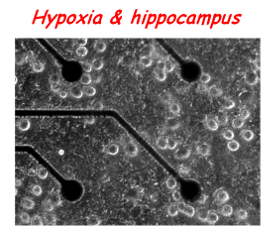MEA recordings in hippocampal networks: alterations induced by hypoxia (HYPOXIA) - CONCLUDED
Aree / Gruppi di ricerca
Partecipanti al progetto
- Carabelli Valentina (Coordinatore/trice)
- (Assegnista)
- Calorio Chiara (Dottorando/a)
- Carbone Emilio (Docente)
- Franchino Claudio (Tecnico/a)
- (Assegnista)
Descrizione del progetto

Members of other units:
Alberto Pasquarelli (Ulm University, Germany)
Partners:
Ulm University
Sponsors:
Università di Torino (ex-60%)
Description
|
Aim of this project is to compare the spontaneous firing activity of cultured hippocampal neurons under normoxic conditions and after a period of chronic hypoxia (2 hours, 3% O2). Taking advantage of the multi-eletrode arrays recording system (MEA), cell activity can be monitored along for several weeks. Action potential generation occurs as single isolated spikes in younger cultures (11 DIV), while in elder cultures (after 18 DIV) action potential are rather generated as synchronized bursts (Gavello et al., 2012). These preliminary data suggest that action potential synchronization is strictly associated to maturation of the culture, even though experimental evidence is lacking on the role of ionic channels in the generation of the different patterns of spontaneous activity. Thus, the first objective of this project will be to determine the role of Na+, Ca2+ e K+ channels under normoxic conditions, and this will be performed by combining the MEA approach together with patch-clamp recordings. To this purpose, since commercially available MEAs are made of TiN, i.e. they are not transparent, to combine simultaneous recordings from the network and single cells, we will use prototypes of diamond-based MEA, realized in collaboration with Prof. A. Pasquarelli, Ulm University, Germany. As a second goal, since chronic hypoxia reduces the firing frequency and increases the synchronization of spontaneous activity, we will monitor the molecular alterations of excitatory and inibitory synapses induced by hypoxic exposure. Experiments will be performed by simultaneously recording from single celsl and from the whole neuronal network along with culture maturation. References: - Carabelli V et al, 2007. Chronic hypoxia up-regulates alpha1H T-type channels and low-threshold catecholamine secretion in rat chromaffin cells. The Journal of Physiology, 584: 149-165 - Gavello D. et al, 2012. Leptin counteracts the hypoxia-induced inhibition of spontaneously firing hippocampal neurons: a microelectrode array study. PLOS ONE, 7 (e41530): 1-17 - Mahapatra et al, 2012. Calcium channel types contributing to chromaffin cell excitability, exocytosis and endocytosis. Cell Calcium 51: 321– 330 |
|
Keywords:
Hippocampal network, Hypoxia, Multi-electrode arrays, Diamond, Spontaneous firing, Ionic channels





